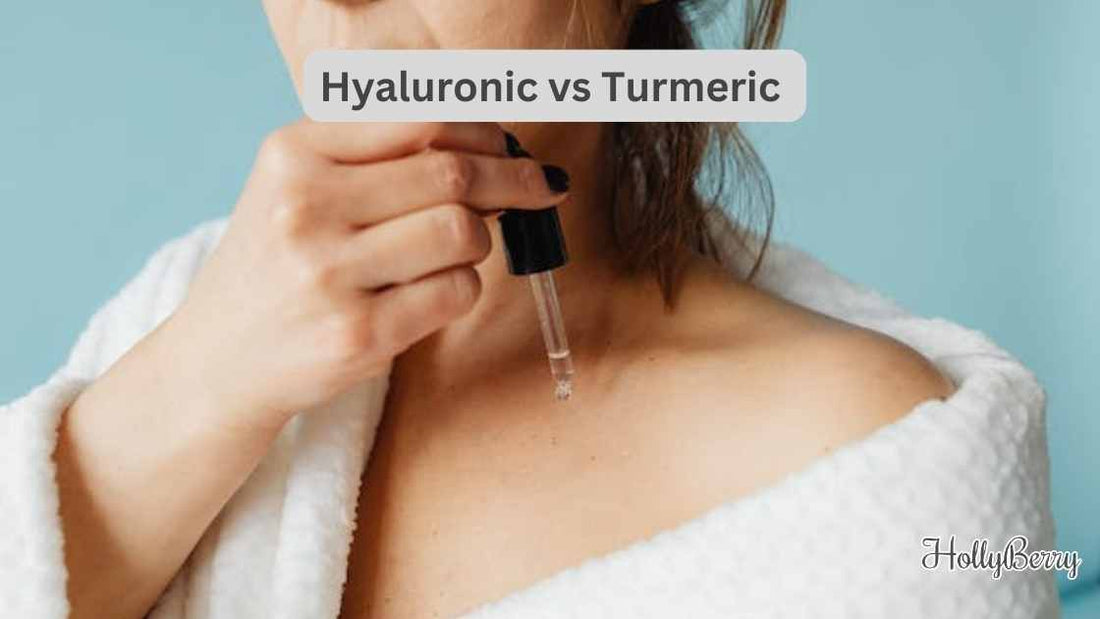
Anti-Inflammatory Properties: Hyaluronic vs Turmeric
Share
Compared in Joint Health Benefits

Within the realm of natural anti-inflammatory agents, hyaluronic acid and turmeric are frequently discussed for their potential therapeutic benefits. Hyaluronic acid, a substance naturally occurring in the human body, is renowned for its role in maintaining skin hydration and elasticity.
Its anti-inflammatory properties are increasingly harnessed in various medical treatments, ranging from osteoarthritis management to post-surgical recovery. The compound facilitates the body's regenerative processes and may reduce inflammation by modulating immune responses.
Turmeric, on the other hand, has been a staple in traditional medicine for centuries, particularly in South Asian cultures. Known scientifically as Curcuma longa, turmeric contains curcuminoids, with curcumin being the most active.
Scientific research suggests that turmeric's anti-inflammatory properties may be attributable to its ability to inhibit certain molecules and enzymes in the inflammation pathway.
Curcumin's antioxidant effects contribute to its overall anti-inflammatory potential, potentially offering relief in conditions such as joint pain and chronic inflammatory diseases.
While both hyaluronic acid and turmeric offer anti-inflammatory advantages, the mechanisms through which they operate differ distinctly.
They represent a class of treatments that may complement each other or stand alone in their therapeutic approaches. However, despite their burgeoning popularity, it's crucial to examine clinical evidence to understand fully the scope and efficacy of each substance in inflammation-related conditions.
Comparative Analysis of Anti-Inflammatory Effects
This section explores the distinctive anti-inflammatory properties of hyaluronic acid and turmeric, assessing their effectiveness and potential in various medical contexts.
Core Anti-Inflammatory Properties
Hyaluronic acid and turmeric, particularly its active compound curcumin, display significant anti-inflammatory effects. Hyaluronic acid functions by moderating the immune response, reducing joint inflammation, and is commonly used in treating osteoarthritis.
Turmeric's curcumin, on the other hand, interferes with molecules that play a role in inflammation, and is noted for its antioxidant properties.
Effectiveness in Treating Arthritis
Both substances have been employed to manage the symptoms of arthritis, offering relief from pain and stiffness. In osteoarthritis cases, hyaluronic acid is often administered intra-articularly to lubricate joints and suppress inflammatory markers. Curcumin from turmeric has been shown to alleviate joint swelling and morning stiffness in rheumatoid arthritis.
Influence on Chronic Diseases
Regular supplementation of curcumin and hyaluronic acid may have a broader impact on chronic diseases such as heart disease, cancer, and diabetes. They target inflammation, which plays a pivotal role in these conditions.
Curcumin has also been linked to the improvement of cholesterol levels and depressive symptoms.
Nutrition and Absorption Factors
Turmeric's bioavailability can be significantly increased with the co-ingestion of black pepper, which contains piperine. This synergy enhances curcumin's absorption and efficacy. Hyaluronic acid is naturally present in some foods, but its stability and absorption as a supplement require further investigation.
Potential Adverse Interactions
While generally considered safe, these compounds can interact with other medications. For instance, curcumin might impede the action of anti-inflammatory drugs such as ibuprofen. Hyaluronic acid is also scrutinized for its comorbidity implications.
Complementary Natural Substances
Curcumin works well with substances like ginger, glucosamine, and vitamin D to enhance anti-inflammatory responses. Similarly, hyaluronic acid can be used alongside these supplements to improve overall joint health and reduce inflammation.
Scientific Studies and Evidence
Evidence from randomised clinical trials and meta-analyses supports the anti-inflammatory benefits of both hyaluronic acid and curcumin. Results from human trials generally indicate positive outcomes, with placebos often used as control measures.
Recommended Dosages and Administration
The American College of Rheumatology provides guidelines for the use of hyaluronic acid in osteoarthritis.
Curcumin dosages vary, but it is essential to note that high doses or long-term use can cause gastrointestinal issues. Both substances should be administered following medical advice to avoid side effects.
Emerging Research and Future Potential
Ongoing research into molecular targets and the potential role of hyaluronic acid and curcumin in emerging health concerns, such as Covid-19, is indicative of their versatility.
Future research is expected to shed further light on their application within supplemental and pharmacokinetic frameworks.
Bioactive Components and Mechanisms
The bioactive components of turmeric and hyaluronic acid contribute significantly to their anti-inflammatory properties. These substances interact with various molecular targets in the body, offering therapeutic effects for conditions like osteoarthritis and systemic inflammation.
Curcumin and Curcuminoids
Curcumin, the principal curcuminoid found in Curcuma longa, exerts strong anti-inflammatory and antioxidant effects. It modulates inflammatory pathways by inhibiting enzymes like cyclooxygenase-2 (COX-2) and reducing pro-inflammatory mediators.
Hyaluronic Acid and Joint Health
Hyaluronic acid (HA), especially present in the synovial fluid, maintains joint health by promoting elasticity and reducing friction. In cases of knee osteoarthritis, HA aids in improving physical function and mitigating arthritis pain.
Antioxidant Properties and Systemic Effects
Both curcumin and hyaluronic acid exhibit antioxidant properties. Curcumin is known to lower biomarkers like triglycerides and blood pressure, while HA has been recognised for its role in conditions like macular degeneration.
Natural Anti-Inflammatory Options
Curcumin and hyaluronic acid serve as natural anti-inflammatory options. Their inclusion in diet and nutrition offers a complementary approach to traditional medications and can benefit conditions like irritable bowel syndrome (IBS) and ulcerative colitis.
Enzymatic Pathways and Molecular Targets
These compounds target specific molecular pathways. For example, curcumin interrupts the activation of matrix metalloproteinase-3 (MMP-3), involved in pro-inflammatory processes, while HA impacts the regulation of various cell signalling pathways relevant to inflammation.
Role in Mental Health and Mood Disorders
Beyond physical ailments, there's emerging evidence that curcumin has beneficial effects on mental health and mood disorders such as depression, possibly due to its anti-inflammatory action on neurological pathways.
Comparing Treatment Efficacy
While both substances boast anti-inflammatory properties, direct comparisons to determine treatment efficacy vary based on the condition, with HA often preferred for joint-related issues and curcumin for its systemic anti-inflammatory effects.
Adjunctive Therapies in Inflammatory Conditions
In conditions like psoriasis, inflammatory bowel disease, and rheumatoid arthritis, these bioactive components are increasingly used as adjunctive therapies, complementing traditional treatments to enhance patient outcomes.
